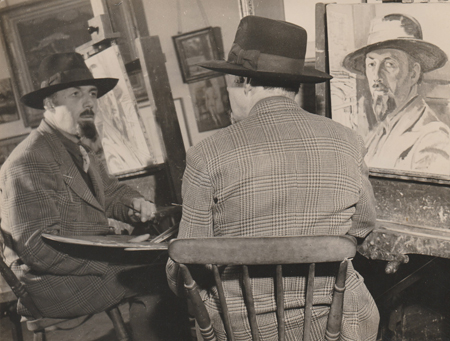Clifford Hall (1904-1973)

Painter in oil and watercolour, draughtsman and etcher, born in London. In the early 1920s he began to study at Richmond Art School, then Putney Art School, 1922-1925, and the Royal Academy Schools, 1926-7.
He was influenced especially by Walter Sickert, and much of Hall's work bears the stamp of Sickert's palette and subject-matter: landscapes, genre scenes and London low life. In the late 1920s he lived in Paris, studying with Andre Lhote.
Had a one-man show at the Beaux Arts Gallery in the mid-1930s, then served with a stretcher party during much of World War II. In 1941 he showed work at the Leger entitled 'Exhibition of War Drawings - Bombs On Chelsea'.
In 1946 he had the first of a number of one-man exhibitions at Roland, Browse and Delbanco, and his monograph on Constantin Guys was published. Making a living in Bohemian Chelsea was often a struggle for Hall, who recorded his experiences in an unpublished journal covering fifty years from the 1920s.
In the early 1960s he began a new series of pictures: women wrapped in towels, usually seen from behind or side on, their faces obscured.
Hall died in 1973. He married one of his students from the Regent Street Polytechnic School of Art, Ann Hewson, in 1956, and they lived in London. In 1957 their son Richard was born.
"We lived in Chelsea until December 1960 when we moved to Bayswater. My mother was his second wife. His first, Julian's mother, Marion Zass, he married in 1933. Julian was born in 1939 - the day before war was declared. Marion was also an artist. They divorced in 1952."
His work is in many public collections in Britain, and abroad, including the Imperial War Museum, Victoria & Albert Museum, and Arts Council. The Belgrave Gallery held a memorial exhibition in 1977; a studio sale took place at Christie's, London, in 1982.
We are grateful to Richard Hall for assistance and the additional information:
Hall painted in tempera and acrylic paint as well as oil and watercolour - watercolours he used fairly rarely actually. He started using tempera for some of his larger paintings in the early 50s and he sometimes used a mixture of tempera and oil paints as well. He started using Cryla Acylic paints in 1966, and most of the larger paintings he did from then on are acrylic on board. Hall quite often wrote 'Acrylic' along with information about the varnish used on the back of his paintings.
Hall studied at the Royal Academy Schools from 1925 to 1927, not 1926 -27. He studied there with Charles Simms, F.Ernest Jackson, Sir George Clausen and Walter Sickert for a few months when Sickert was a visiting master at the Schools. While there he won a Landseer scholarship in painting: only one student a year could win this award. The scholarship meant he had enough money to rent his own studio in Twickenham in 1927, where he received and completed a number of portrait commissions. One of these was for a full length portrait of Sir Henry Norris, the then chairman of Arsenal Football Club and former Mayor of Fulham. For this he earned 100 guineas - about £5,500 in today's money.
His portrait commissions are what gave him enough money to go to France for an extended period.
Hall really only studied briefly with Andre Lhote in Paris and though he liked him Lhote did not have any significant influence on his technique or style.
A one-man show at the Beaux Arts Gallery was in held 1935. It was not his first one-man show as many sources state it was actually his third.
His first was at the St Martin's Gallery, London WC2 in 1929.
He made £80 from it and used the money to go back to Paris. His second was at the Leger Gallery in 1932. He first met Lillian Browse when she was working for Harold Leger in the early 30s. After the Beaux Arts Gallery show he had two more at the Leger: in 1938 and 1941. His other shows at Roland, Browse and Delbanco were in 1947 and 1950.
Hall's Bathers' series started in the early 1960s. They evolved gradually, predated by paintings from as early as the mid-forties which presage the bathers. The main difference between the early bathers and the late bathers is that from 1966 onwards most of them were acrylic on board whereas before they were mostly oil on canvas. The oil painting bathers are mostly painted in rather sombre colours whereas the acrylic paintings are generally much higher in key.
Photograph with thanks to The Estate of Clifford Hall